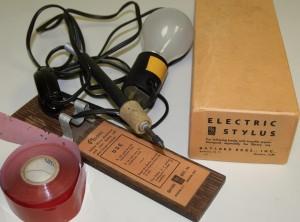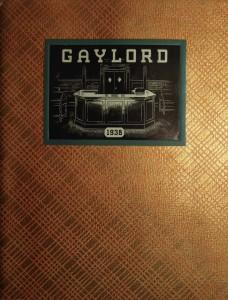 During a recent cleaning and reorganization campaign in our conservation lab, I happened upon a curious looking artifact of yore; an electric stylus, also known as a electro pencil used for applying call numbers to the spines of books.
During a recent cleaning and reorganization campaign in our conservation lab, I happened upon a curious looking artifact of yore; an electric stylus, also known as a electro pencil used for applying call numbers to the spines of books.
First introduced around 1927 by Gaylord Brothers, the electric stylus was a heat tool used with a transfer paper ribbon coated with a colorant. The ribbons came in a variety of colors, including gold.
Our version of the stylus relied on a light bulb, rather than a rheostat, to regulate the current supplied. A label on the stand supplied indicates which wattage of tungsten bulb was appropriate for short-term or long-term use.
A later version of the stylus plugged directly into an outlet and the directions stated that the “tip must sizzle when wet finger is applied”. Testing the temperature with a dry finger obviously is not recommended!
Since the tapes came in a variety of colors it was easy to apply permanent and legible call numbers to books with different colors and types of coverings. In 1951 the stylus cost $3.50 and while a version is still available for $56.25, we moved to a different labeling technique many years ago.
 Today Hagley uses foil backed paper labels with acrylic heat set adhesive. The new labels are computer printed during the cataloging process.
Today Hagley uses foil backed paper labels with acrylic heat set adhesive. The new labels are computer printed during the cataloging process.
While I researched the history of this artifact, I found that the company, Gaylord, has an interesting history. Founded in 1896, it still provides an array of supplies for repair, storage and display of library materials. According to the Gaylord Brothers publication “Bookcraft: Simple Techniques for Maintenance and Repair of Books”, the company has been offering advice on the care of books since 1924. Their very first product was a gummed glassine paper tape, developed by the Gaylord Brothers in 1896.
Willis and Henry Gaylord were two bankers who “were confronted daily with … mending torn bank bills”. Feeling stuck in the lower ranks of the banking world and looking to expand their horizons, they sent samples of the tape to local banks, requesting a small payment or return of the product.
Gradually word of the tape got around to a librarian who requested a version made with cloth for repairing books. From there, they increased the product line, largely by listening to their customers' needs and displaying their wares at American Library Association meetings.
Many of the materials used for durable repair of circulating books are not reversible and should not be used on rare items or books of historic or aesthetic value. To their credit, Bookcraft distinguishes between the level of care appropriate for public libraries and the more considered care to be used on research collections preserved for the long term. It states: “Experience has shown that it is not advisable to use book repair tapes on research collections with long-term value.... It is better to box or wrap a valuable volume than treat it incorrectly.”
This advice can very well apply to damaged personal library collections where the initial instinct may be to slap a piece of Scotch® tape on it.
Laura Wahl is the library conservator at Hagley Museum and Library.
